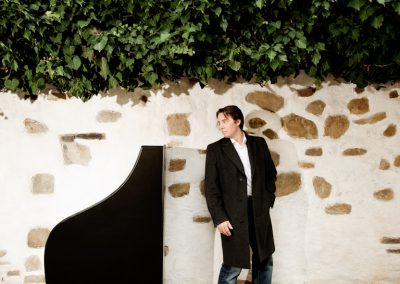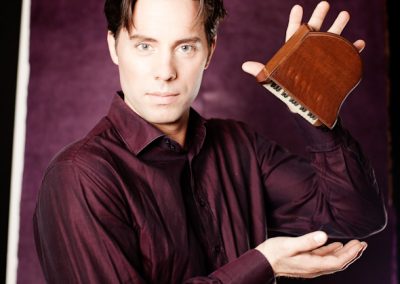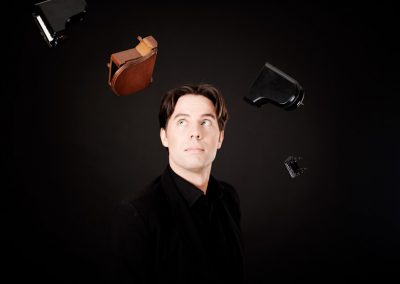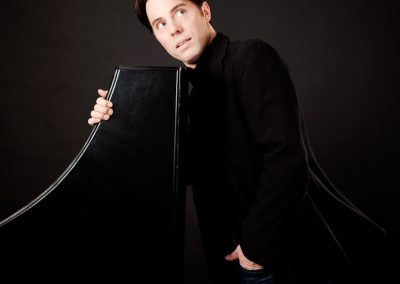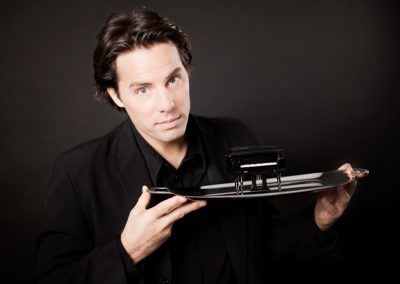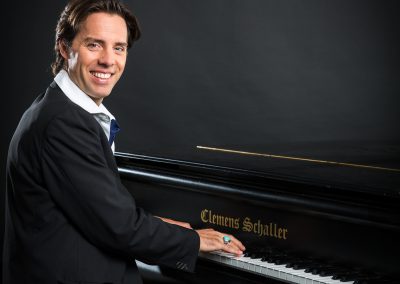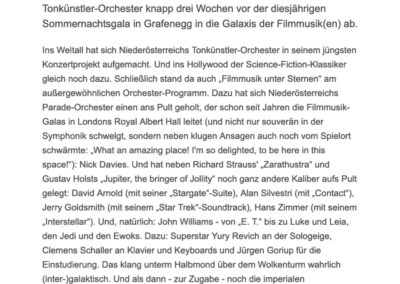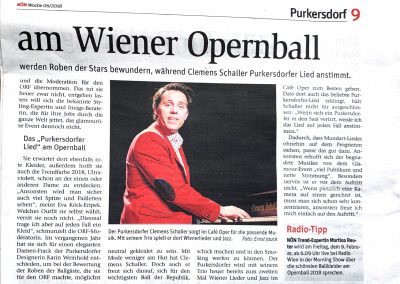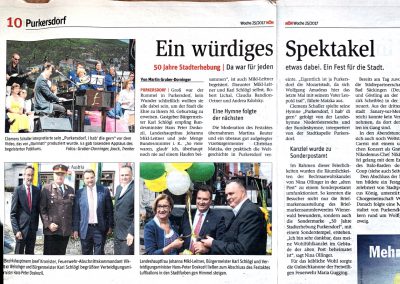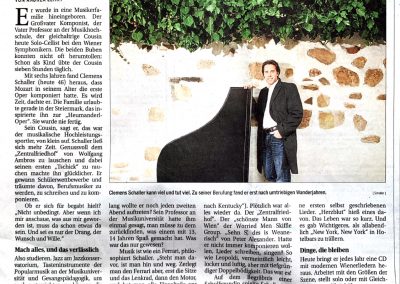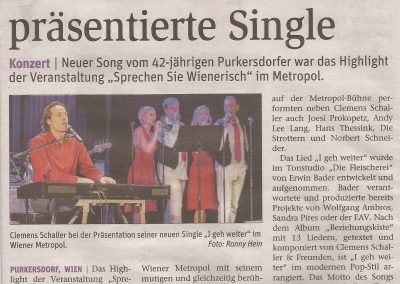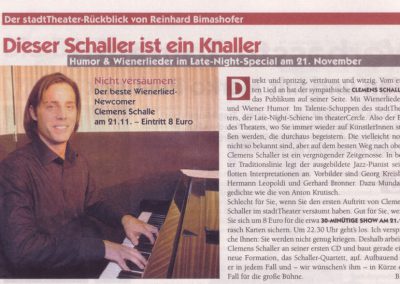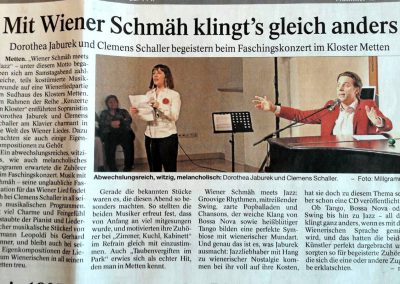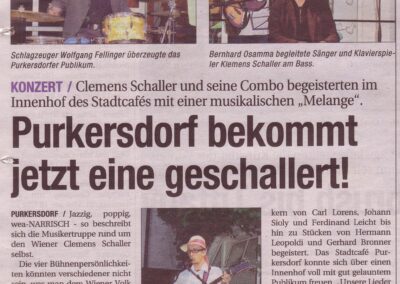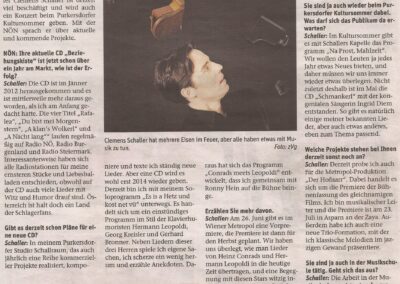about me
about me
Clemens Schaller
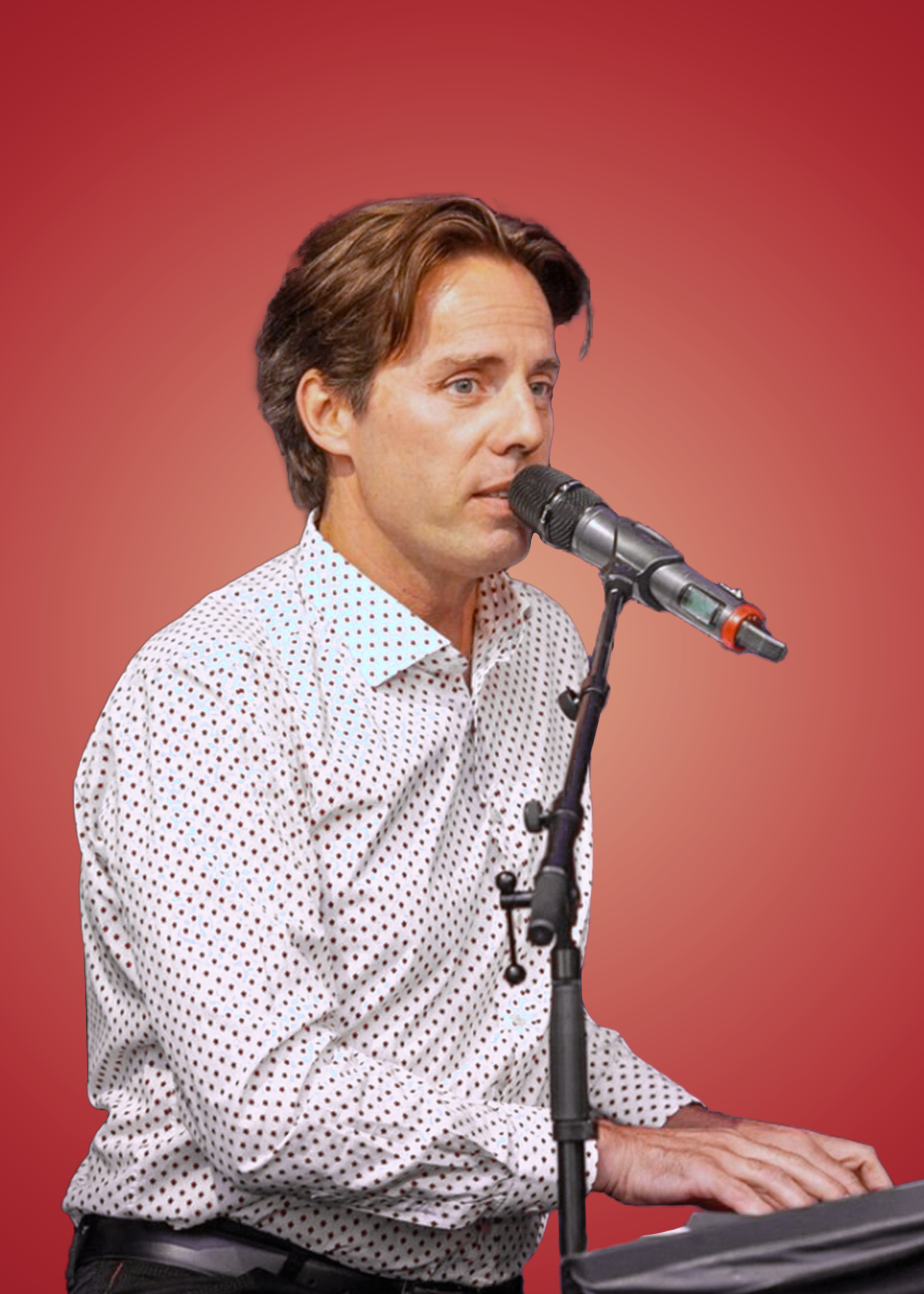

Clemens Schaller studied concert jazz piano at the Music and Arts University of the City of Vienna (MUK) and keyboard instruments of popular music at the University of Music and Performing Arts Vienna (mdw).
Er ist ein Pianist, Sänger, Komponist, Arrangeur und musikalischer Leiter. Clemens Schaller spielt mit renommierten nationalen und internationalen Künstler:innen und ist Teil vielfältiger Produktionen. So spielte er in der World of Hans Zimmer-Show in Taiwan, Hollywood in Vienna, mit den Wiener Symphonikern oder dem Tonkünstler-Orchester NÖ. Er war auf der Bühne mit Alexandra Burke, Alan Menken, Nick Davis, Randy Kerber, André Heller, Uwe Kröger oder Maya Hakvoort.
Schaller operates his own recording studio called 'SchallRaum' in Purkersdorf in the Vienna Woods. He also performs in concerts in the style of piano humorists Hermann Leopoldi and Georg Kreisler. Furthermore, Schaller is active as a songwriter, composer, and arranger for theatrical productions.
Clemens Schaller ist Jazzklavierlehrer und Chorleiter für den Musikschulverband Wienerwald-Mitte. Zudem ist er als Lehrbeauftragter an der Musikuniversität Wien tätig. Zur Unterstützung dieser Arbeit entstand die neue Rhythmusschule „The Polybible of Rhythm“.
Purkersdorf
Testimonials
We have been working with Clemens Schaller for several years now and appreciate his balanced, highly professional approach to the various shows. And when it comes to the stage after short, intense rehearsals, Clemens once again demonstrates his skills and impresses not only as a musician and band leader but also as an entertainer. SCROOGE and AUGUSTIN were big successes, and we will build on this.
Bettina Weyers
Gallissas Theaterverlag und Mediaagentur GmbH Berlin
https://www.gallissas-verlag.de
Clemens Schaller, as the musical director of our annual Children's Castle Benefit Concert, has been working together with a number of renowned singers for many years to create concert evenings of the highest caliber. This significantly contributes to helping families regain some strength after the death or serious illness of a child or parent, following a difficult period. Thank you very much for this wonderful collaboration and support!
Christine Marek
Kinderburgbotschafterin der Kinderbug Rappottenstein/Rotes Kreuz
https://www.kinderburg-rappottenstein.at
Since 2008, I have had the privilege of working alongside Clemens Schaller to develop, conceptualize, and implement a wide range of musical concepts for our events. Clemens is not only one of Austria's finest musicians but also highly professional in organizing and coordinating musical concepts. He handles every challenge with the utmost professionalism and delivers the best possible results. Here's to many more successful events together, Mr. Piano Man.
Maryam Yeganehfar
yamyam Eventproductions
https://www.yamyam.at
With his immense musicality, professionalism, and, last but not least, his calm demeanor, Clemens Schaller, as the musical director of our annual charity concert in support of 'Licht ins Dunkel,' manages to shine a spotlight on our business professionals, who are enthusiastic amateur musicians, and captivate our audience time and time again. This allows us to support heavily burdened families through the 'Licht ins Dunkel Soforthilfefonds' (Immediate Aid Fund) every year.
Thomas Zanyath und Christine Marek
https://www.managermachenmusik.at
Clemens represents reliable quality and versatility. Consequently, his list of credits is quite extensive. I have repeatedly experienced him as a conductor at the Metropol musicals - and with increasing pleasure. When it comes to keyboardists and pianists, I don't know many who are capable of providing such sensitive accompaniment as Clemens Schaller.
I also greatly appreciate him as a songwriter. What he creates in that realm sounds as if Hermann Leopoldi, Georg Danzer, and Thomas Spitzer had come together for a creative session. All in all, I can only say: it doesn't get any better than this.
Peter Hofbauer
Wiener Metropol
https://www.wiener-metropol.at
Short Stories
Short
Stories
How I learned to love Mozart, Ambros, and Oscar Peterson
I was born into a family of musicians. My grandfather, Erwin Schaller (1904-1984), composed and arranged folk song settings and chamber music in a contrapuntal style. In 1936, he published the 'Gitarrenschule Schaller-Scheidt' (Schaller-Scheidt Guitar School), and his practice pieces continue to be taught and used in instruction to this day.
My father, Helmut Schaller (1944-2022), started performing with his recorder when he was just six years old. Later, he became a university professor and a specialist in Early Music. He traveled the world with his Baroque trio Linz-Wien. For me, all of that seemed old-fashioned, and I didn't even want to learn to read sheet music. But music wasn't entirely unimportant to me. During a vacation in Styria, I was shocked to realize that Mozart had already composed his first opera at the age of six - the same age I was at the time. I need to do something, I thought, and started working on my 'Heumanderl Opera.' I didn't get very far.
When I was eleven years old, my father took me to his summer academy in Bavaria. I wasn't particularly interested in what his music students were learning there, but in the evenings, I helped out in the bar. I used the tips I earned to buy cigarettes, sat with the students, and sang 'Es lebe der Zentralfriedhof' with them. That was my first encounter with Wolfgang Ambros. A few more real ones followed.
My parents sent me to music school, and there, I bluffed my way through. It took my piano teacher three years to find out that I couldn't actually read sheet music. I just played by ear. At the age of 14, right after winning a composition competition, I wanted to quit. My parents forbade it. At 18, I finally prevailed: no more classical piano! I enrolled in a jazz course and discovered my love for Oscar Peterson. How I wanted to play like him! But unfortunately, you also needed to master the classical repertoire inside out and be really good at it for that. Well, it turns out you can't skip the practice after all...
Stalking Peter Alexander
"Look, a famous singer lives in the house across the street!" Whenever I visited my 'Grinzing Grandma' on Paul-Ehrlich-Gasse, she would point to Peter Alexander's villa. This was in 1979 when I was eight years old, and I had no idea who she was talking about, partly because I grew up without a television. It all became clear in 1983 when I heard Peter Alexander's version of 'Sehn's, des is' Weanerisch' by Carl Lorens on the radio. Peter Alexander sang it for German television and translated verse by verse into standard German. I was fascinated. That was my awakening to dialects.
Later, I paid tribute to the great actor and singer on stage with the program 'The Golden 50s.' In it, I sing many songs that he had also sung. On the CD 'des is jo des,' there is a song dedicated to his former villa in Grinzing. It's called 'Das Haus gegenüber' (The House Across).
From Saunaquartier to Fürstenpalast
In 1996, I was studying music and wanted to perform on stage as often as possible. That's when I had an idea: I walked into the Austrian Tourism Office and obtained the addresses of the top 100 hotels in the country. I wrote to all of them personally—back then, of course, by hand-written letters.
"Are you perhaps looking for a bassist and a pianist for your hotel bar this summer?" I was referring to my friend Raphael Preuschl and myself. Ten hoteliers requested audio samples. Three of them invited us to come and demonstrate our skills.
Our first stop was the Krallerhof Hotel in Leogang. Raphael and I played our hearts out. It was a success. The next morning, the director came to us and said, 'Guys, you can stay. I can't pay you much; we just renovated recently. But you'll get board and lodging.' That meant three fantastic meals a day and two mattresses in the former sauna – quite cool for us young guys.
In that first month, we played almost every evening. We didn't even visit the other two hotels anymore. Later, my engagements took me from Gstaad to Munich, from Dubrovnik to Monaco. But one venue in my musical career has remained until today: the Krallerhof Hotel. My collaboration with the Altenberger family has been and continues to be a special and diverse enrichment.
Herzblut
In 2005, a turning point occurred. Lisi, a dear childhood friend and by then a mother of two, died in a car accident. I was 34 years old and had performed at countless events. Her death made me question many things. Was this really all I wanted to achieve in life? It was so short; shouldn't I also pursue what I truly wished for deep down inside?
I wanted to compose. That's why I had ventured into music in the first place. Three instrumental pieces flowed effortlessly from my pen. They are published on the CD "Herzblut'". I played the first one at Lisi's funeral. I donated the proceeds to Lisi's children.
Composing opened a new old door for me. It remains my passion to this day, including for projects commissioned by my clients at Studio SchallRaum.
Why Georg Kreisler wrote me a letter
In 2009, by then 38 years old, I read in the 'Standard' newspaper about former Finance Minister Karl-Heinz Grasser receiving over ten million euros as a testimonial from Meinl Bank. The fund he had endorsed went bankrupt due to illegal buybacks, and Grasser had promoted it as a safe investment.
I was extremely frustrated. What could a small musician like me do against such scams?" I wondered. Then, I remembered Gerhard Bronner's song 'Der Papa wird’s schon richten' (Dad will handle it), which had led to the resignation of the then Interior Minister. "I can do that too!" I thought and wrote the parody 'Die Ich-AG' (The Ego Corporation), which is featured on the CD 'Beziehungskiste'.
The song made an impact on YouTube. Grasser didn't resign because of it; he already had. I would have loved to thank Gerhard Bronner, but he had already passed away. That left Georg Kreisler, Bronner's arch-rival, whom I also held in high regard. I sent him the recording. He replied promptly, stating that he was very impressed by the song and piano playing but had always stayed away from current political topics due to their short-lived relevance.
Two years later, he also passed away. His letter is still framed and hangs in my studio to this day.
Spotlight & SchallRaum
In 2011, I had rediscovered my core passion: creating my own music! I should have known this since the 'Heumanderl Opera' at age 6 or the composition competition I won at 14.
The 'Herzblut' CD was my initial spark. More momentum came with the KHG parody 'Die Ich-AG.' This was followed by 'Du bist mein Morgenstern,' a love song for my wife Birgit. A radio listener wrote, 'My husband and I found each other again and fell in love anew while listening to this song.'
In collaboration with the two lyricists Thomas Strobl and Josef Köber, I released the CD 'Beziehungskiste' in 2012. And I formed my first band, 'Schallers Kapelle,' with Ingrid Diem, Christoph Helm, Bernhard Osanna, and Wolfgang Fellinger.
What else does a songwriter and producer need? A studio of their own! I found one in Herrengasse, Purkersdorf. To this day, I compose, write lyrics, and arrange there, both for myself and for others. My style? It should be humorous and evoke positive emotions, that's the common thread. I want people to be emotionally touched by my music and feel well taken care of. That's my mission.
Youth dreams reloaded
I've known Bernhard Kronowetter since school. We often sat with his guitar on Roter Berg and dreamed of becoming musicians. Back then, we also had a choir with nine singers, called 'Piaccapellano.' It was an a cappella choir with piano accompaniment. Technically, a contradiction in terms, but it was beautiful.
In 2014, we reconnected. Bernd approached me after a concert at Vienna's 'Metropol.' He had long stopped singing, but the concert reignited his passion. He didn't have to tell me twice! In homage to Pirron & Knapp, we called ourselves Schaller & Bernd, co-wrote the songs for the CD 'Des is jo des,' and gave some wonderful concerts together.
Then we dove into the next idea, one that Bernd had already been successful with before: YourTeamSong. We visit companies and record a song with the employees. And the best part: the people don't know what to expect. Yes, it's true: in two hours, we create music, lyrics, and recording, and the team gets a download link to enjoy their own team song for a long time.
Why I wore shoes of different colors
Birgit and I have two wonderful children, Alina and Nico. In 2012, the two of them came to me with a serious question. They had big aspirations: Alina, who was 15 at the time, wanted to become a star actress, and Nico aimed for Olympic gold in diving. 'What if we don't make it?' they asked me. 'What then?' 'Don't worry,' I replied, 'big goals are important. And if it doesn't work out, you get up and keep going.'
After that conversation, I became quite contemplative. Then, I sat down at the piano and wrote the song 'I geh' weiter' (I keep going). Ronnie Hein produced the video for it. In one part of the video, I pluck shoes from a tree ('naturally grown footwear'), and I end up with two different-colored ones. I liked the idea. For the next seven years, I walked around with two different shoes. They reminded me that everything has two sides. I believe in individuality, diversity, and a variety of opinions - these things are important to me.
In 2020, from one day to the next, I started wearing matching shoes again. The other had become a compulsion, a dogma. I don't like dogmas, especially not self-imposed ones. I can express my values in other ways. However, my car still has two differently colored side mirrors.
Rhythm for Eternity
One of my teachers at the conservatory always used to say, 'If you want to play many gigs, learn to play all songs in all keys.' He couldn't have given me a better lesson. In 1996, during my first engagement at Krallerhof, I actually practiced that. Soon, it became easy for me to play the entire repertoire in all twelve keys. It provides security, a system in which you can reliably navigate.
But what I didn't understand was: Why does one number groove and the other doesn't? What does it depend on? I searched for the key for a long time in vain. I found it during a trip to Morocco. We were traveling by bus from Marrakech over the Atlas Mountains, the driver was playing Moroccan music, it was grooving intensely, and I was tapping my fingers along. But the system that these musicians were referring to didn't become clear to me. Then I had an idea: If you learn and internalize all the speed ratios that exist up to the number 12 – so 2:3, 3:4, 5:7, and all the others – if you learn them all, you create a template for yourself. With its help, you should be able to recognize and reproduce everything you encounter in music, whether in heard, written, or improvised form.
So, I started practicing all mathematical ratios from 1 to 12. With the higher numbers, like 7:11, the number line you had to visualize was quite long. One morning, I had an insight: What if you bend the ends of this number line together and form it into a circle, and then divide it using polygons, in other words, many-sided shapes. It worked! Even very complex rhythms were suddenly visible at a glance.
As a result, I composed 16 piano pieces that incorporate all 34 polyrhythms, the so-called 'Polytüden.' A pianist who plays these pieces can practice all polyrhythms up to the number 12 – and they will all groove. The pieces are published in my book 'The Polybible of Rhythm,' and the method is explained comprehensively there.
This insight has greatly enriched my teaching at the Music School Wienerwald Mitte and at the University of Music and Performing Arts Vienna. These rhythms are for eternity!
How I learned to love Mozart, Ambros, and Oscar Peterson
I was born into a family of musicians. My grandfather, Erwin Schaller (1904-1984), composed and arranged folk song settings and chamber music in a contrapuntal style. In 1936, he published the 'Gitarrenschule Schaller-Scheidt' (Schaller-Scheidt Guitar School), and his practice pieces continue to be taught and used in instruction to this day.
My father, Helmut Schaller (1944-2022), started performing with his recorder when he was just six years old. Later, he became a university professor and a specialist in Early Music. He traveled the world with his Baroque trio Linz-Wien. For me, all of that seemed old-fashioned, and I didn't even want to learn to read sheet music. But music wasn't entirely unimportant to me. During a vacation in Styria, I was shocked to realize that Mozart had already composed his first opera at the age of six - the same age I was at the time. I need to do something, I thought, and started working on my 'Heumanderl Opera.' I didn't get very far.
When I was eleven years old, my father took me to his summer academy in Bavaria. I wasn't particularly interested in what his music students were learning there, but in the evenings, I helped out in the bar. I used the tips I earned to buy cigarettes, sat with the students, and sang 'Es lebe der Zentralfriedhof' with them. That was my first encounter with Wolfgang Ambros. A few more real ones followed.
My parents sent me to music school, and there, I bluffed my way through. It took my piano teacher three years to find out that I couldn't actually read sheet music. I just played by ear. At the age of 14, right after winning a composition competition, I wanted to quit. My parents forbade it. At 18, I finally prevailed: no more classical piano! I enrolled in a jazz course and discovered my love for Oscar Peterson. How I wanted to play like him! But unfortunately, you also needed to master the classical repertoire inside out and be really good at it for that. Well, it turns out you can't skip the practice after all...
Stalking Peter Alexander
"Look, a famous singer lives in the house across the street!" Whenever I visited my 'Grinzing Grandma' on Paul-Ehrlich-Gasse, she would point to Peter Alexander's villa. This was in 1979 when I was eight years old, and I had no idea who she was talking about, partly because I grew up without a television. It all became clear in 1983 when I heard Peter Alexander's version of 'Sehn's, des is' Weanerisch' by Carl Lorens on the radio. Peter Alexander sang it for German television and translated verse by verse into standard German. I was fascinated. That was my awakening to dialects.
Later, I paid tribute to the great actor and singer on stage with the program 'The Golden 50s.' In it, I sing many songs that he had also sung. On the CD 'des is jo des,' there is a song dedicated to his former villa in Grinzing. It's called 'Das Haus gegenüber' (The House Across).
From Saunaquartier to Fürstenpalast
In 1996, I was studying music and wanted to perform on stage as often as possible. That's when I had an idea: I walked into the Austrian Tourism Office and obtained the addresses of the top 100 hotels in the country. I wrote to all of them personally—back then, of course, by hand-written letters.
"Are you perhaps looking for a bassist and a pianist for your hotel bar this summer?" I was referring to my friend Raphael Preuschl and myself. Ten hoteliers requested audio samples. Three of them invited us to come and demonstrate our skills.
Our first stop was the Krallerhof Hotel in Leogang. Raphael and I played our hearts out. It was a success. The next morning, the director came to us and said, 'Guys, you can stay. I can't pay you much; we just renovated recently. But you'll get board and lodging.' That meant three fantastic meals a day and two mattresses in the former sauna – quite cool for us young guys.
In that first month, we played almost every evening. We didn't even visit the other two hotels anymore. Later, my engagements took me from Gstaad to Munich, from Dubrovnik to Monaco. But one venue in my musical career has remained until today: the Krallerhof Hotel. My collaboration with the Altenberger family has been and continues to be a special and diverse enrichment.
Herzblut
In 2005, a turning point occurred. Lisi, a dear childhood friend and by then a mother of two, died in a car accident. I was 34 years old and had performed at countless events. Her death made me question many things. Was this really all I wanted to achieve in life? It was so short; shouldn't I also pursue what I truly wished for deep down inside?
I wanted to compose. That's why I had ventured into music in the first place. Three instrumental pieces flowed effortlessly from my pen. They are published on the CD "Herzblut'". I played the first one at Lisi's funeral. I donated the proceeds to Lisi's children.
Composing opened a new old door for me. It remains my passion to this day, including for projects commissioned by my clients at Studio SchallRaum.
Why Georg Kreisler wrote me a letter
In 2009, by then 38 years old, I read in the 'Standard' newspaper about former Finance Minister Karl-Heinz Grasser receiving over ten million euros as a testimonial from Meinl Bank. The fund he had endorsed went bankrupt due to illegal buybacks, and Grasser had promoted it as a safe investment.
Ich ärgerte mich maßlos. Was kann ich als kleiner Musikergegen solche Betrügereien ausrichten?, fragte ich mich. Da erinnerte ich mich an Gerhard Bronners „Der Papa wird’s schon richten“. Das hatte seinerzeit immerhin den Rücktritt des damaligen Innenministers zur Folge. Das kann ich auch!, dachte ich und schrieb die Parodie „Die Ich-AG“, die auf der CD „Beziehungskiste veröffentlicht ist.
The song made an impact on YouTube. Grasser didn't resign because of it; he already had. I would have loved to thank Gerhard Bronner, but he had already passed away. That left Georg Kreisler, Bronner's arch-rival, whom I also held in high regard. I sent him the recording. He replied promptly, stating that he was very impressed by the song and piano playing but had always stayed away from current political topics due to their short-lived relevance.
Two years later, he also passed away. His letter is still framed and hangs in my studio to this day.
Spotlight & SchallRaum
In 2011, I had rediscovered my core passion: creating my own music! I should have known this since the 'Heumanderl Opera' at age 6 or the composition competition I won at 14.
The 'Herzblut' CD was my initial spark. More momentum came with the KHG parody 'Die Ich-AG.' This was followed by 'Du bist mein Morgenstern,' a love song for my wife Birgit. A radio listener wrote, 'My husband and I found each other again and fell in love anew while listening to this song.'
In collaboration with the two lyricists Thomas Strobl and Josef Köber, I released the CD 'Beziehungskiste' in 2012. And I formed my first band, 'Schallers Kapelle,' with Ingrid Diem, Christoph Helm, Bernhard Osanna, and Wolfgang Fellinger.
What else does a songwriter and producer need? A studio of their own! I found one in Herrengasse, Purkersdorf. To this day, I compose, write lyrics, and arrange there, both for myself and for others. My style? It should be humorous and evoke positive emotions, that's the common thread. I want people to be emotionally touched by my music and feel well taken care of. That's my mission.
Youth dreams reloaded
I've known Bernhard Kronowetter since school. We often sat with his guitar on Roter Berg and dreamed of becoming musicians. Back then, we also had a choir with nine singers, called 'Piaccapellano.' It was an a cappella choir with piano accompaniment. Technically, a contradiction in terms, but it was beautiful.
In 2014, we reconnected. Bernd approached me after a concert at Vienna's 'Metropol.' He had long stopped singing, but the concert reignited his passion. He didn't have to tell me twice! In homage to Pirron & Knapp, we called ourselves Schaller & Bernd, co-wrote the songs for the CD 'Des is jo des,' and gave some wonderful concerts together.
Then we dove into the next idea, one that Bernd had already been successful with before: YourTeamSong. We visit companies and record a song with the employees. And the best part: the people don't know what to expect. Yes, it's true: in two hours, we create music, lyrics, and recording, and the team gets a download link to enjoy their own team song for a long time.
Warum ich verschieden- farbige Schuhe trug
Birgit and I have two wonderful children, Alina and Nico. In 2012, the two of them came to me with a serious question. They had big aspirations: Alina, who was 15 at the time, wanted to become a star actress, and Nico aimed for Olympic gold in diving. 'What if we don't make it?' they asked me. 'What then?' 'Don't worry,' I replied, 'big goals are important. And if it doesn't work out, you get up and keep going.'
After that conversation, I became quite contemplative. Then, I sat down at the piano and wrote the song 'I geh' weiter' (I keep going). Ronnie Hein produced the video for it. In one part of the video, I pluck shoes from a tree ('naturally grown footwear'), and I end up with two different-colored ones. I liked the idea. For the next seven years, I walked around with two different shoes. They reminded me that everything has two sides. I believe in individuality, diversity, and a variety of opinions - these things are important to me.
In 2020, from one day to the next, I started wearing matching shoes again. The other had become a compulsion, a dogma. I don't like dogmas, especially not self-imposed ones. I can express my values in other ways. However, my car still has two differently colored side mirrors.
Rhythm for Eternity
One of my teachers at the conservatory always used to say, 'If you want to play many gigs, learn to play all songs in all keys.' He couldn't have given me a better lesson. In 1996, during my first engagement at Krallerhof, I actually practiced that. Soon, it became easy for me to play the entire repertoire in all twelve keys. It provides security, a system in which you can reliably navigate.
But what I didn't understand was: Why does one number groove and the other doesn't? What does it depend on? I searched for the key for a long time in vain. I found it during a trip to Morocco. We were traveling by bus from Marrakech over the Atlas Mountains, the driver was playing Moroccan music, it was grooving intensely, and I was tapping my fingers along. But the system that these musicians were referring to didn't become clear to me. Then I had an idea: If you learn and internalize all the speed ratios that exist up to the number 12 – so 2:3, 3:4, 5:7, and all the others – if you learn them all, you create a template for yourself. With its help, you should be able to recognize and reproduce everything you encounter in music, whether in heard, written, or improvised form.
So, I started practicing all mathematical ratios from 1 to 12. With the higher numbers, like 7:11, the number line you had to visualize was quite long. One morning, I had an insight: What if you bend the ends of this number line together and form it into a circle, and then divide it using polygons, in other words, many-sided shapes. It worked! Even very complex rhythms were suddenly visible at a glance.
As a result, I composed 16 piano pieces that incorporate all 34 polyrhythms, the so-called 'Polytüden.' A pianist who plays these pieces can practice all polyrhythms up to the number 12 – and they will all groove. The pieces are published in my book 'The Polybible of Rhythm,' and the method is explained comprehensively there.
This insight has greatly enriched my teaching at the Music School Wienerwald Mitte and at the University of Music and Performing Arts Vienna. These rhythms are for eternity!
Contact
Clemens Schaller – Studio Schallraum
Studio SchallRaum, Herrengasse 8/1/13, 3002 Purkersdorf
5 minutes walking distance from Purkersdorf Zentrum S-Bahn station
